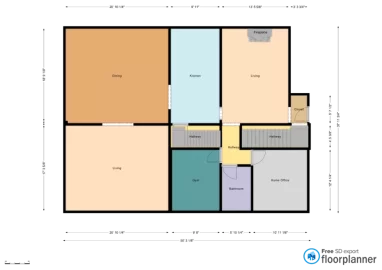I built a new addition onto my house, and, as I expected, heat does not flow into the new part from my existing PE FP25. The fireplace heated the old part of the house just fine, even on the coldest of days. Most of the time, my issue was getting the house too warm. I can still get the old part into the high 70s and 80s if I'm not careful, but that does not migrate into my new addition.
My question here is, would a heat distribution kit push a decent amount of heat to my new part, or should I be looking at wood furnaces for the basement for better heat distribution? I included a floor plan of the first floor of my house as it is that I drew with the website Floorplanner and while walking around my house with a tape measure. The new part is the living and dining rooms on the left hand side of the picture. The existing fireplace is in the top right corner. Under the entire structure is a full basement.
I'd like to use both ports out of the FP25 if I could, and have two runs to the new part, one to each room. Alternatively, I could dump all of the heat into the new dining room, and some would no doubt migrate into the new living room.

My question here is, would a heat distribution kit push a decent amount of heat to my new part, or should I be looking at wood furnaces for the basement for better heat distribution? I included a floor plan of the first floor of my house as it is that I drew with the website Floorplanner and while walking around my house with a tape measure. The new part is the living and dining rooms on the left hand side of the picture. The existing fireplace is in the top right corner. Under the entire structure is a full basement.
I'd like to use both ports out of the FP25 if I could, and have two runs to the new part, one to each room. Alternatively, I could dump all of the heat into the new dining room, and some would no doubt migrate into the new living room.


